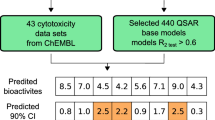Abstract
In this work, we calculated the pair wise chemical similarity for a subset of small molecules screened against the NCI60 cancer cell line panel. Four different compound similarity calculation methods were used: Brutus, GRIND, Daylight and UNITY. The chemical similarity scores of each method were related to the biological similarity data set. The same was done also for combinations of methods. In the end, we had an estimate of biological similarity for a given chemical similarity score or combinations thereof. The data from above was used to identify chemical similarity ranges where combining two or more methods (data fusion) led to synergy. The results were also applied in ligand-based virtual screening using the DUD data set. In respect to their ability to enrich biologically similar compound pairs, the ranking of the four methods in descending performance is UNITY, Daylight, Brutus and GRIND. Combining methods resulted always in positive synergy within a restricted range of chemical similarity scores. We observed no negative synergy. We also noted that combining three or four methods had only limited added advantage compared to combining just two. In the virtual screening, using the estimated biological similarity for ranking compounds produced more consistent results than using the methods in isolation.











Similar content being viewed by others
References
Martin YC, Kofron JL, Traphagen LM (2002) J Med Chem 45:4350
Willett P (2006) Drug Discov Today 11:1046
Goodford PJ (1985) J Med Chem 28:849
Pastor M, Cruciani G, McLay I et al (2000) J Med Chem 43:3233
Tervo AJ, Ronkko T, Nyronen TH et al (2005) J Med Chem 48:4076
Ronkko T, Tervo AJ, Parkkinen J et al (2006) J Comput Aided Mol Des 20:227
Willett P (2006) QSAR Comb Sci 25:1143
Muchmore SW, Debe DA, Metz JT et al (2008) J Chem Inf Model 48:941
Wallqvist A, Huang R, Thanki N et al (2006) J Chem Inf Model 46:430
Wang H, Klinginsmith J, Dong X et al (2007) J Chem Inf Model 47:2063
Covell DG, Wallqvist A, Huang R et al (2005) Proteins 59:403
Rabow AA, Shoemaker RH, Sausville EA et al (2002) J Med Chem 45:818
Wallqvist A, Huang R, Covell DG (2007) J Chem Inf Model 47:1414
Huang N, Shoichet BK, Irwin JJ (2006) J Med Chem 49:6789
Benedetti P, Mannhold R, Cruciani G et al (2002) J Med Chem 45:1577
Cianchetta G, Singleton RW, Zhang M et al (2005) J Med Chem 48:2927
Cratteri P, Romanelli MN, Cruciani G et al (2004) J Comput Aided Mol Des 18:361
Gasteiger JR, Sadowski CJ (1990) Tetrahedron Comp Method 3:537
Fontaine F, Pastor M, Sanz F (2004) J Med Chem 47:2805
Whittle M, Gillet VJ, Willett P et al (2006) J Chem Inf Model 46:2206
Truchon JF, Bayly CI (2007) J Chem Inf Model 47:488
Brown N, Jacoby E (2006) Mini Rev Med Chem 6:1217
Acknowledgments
This study was supported by the Marie Curie Canceromics (MEXT-CT-2003-2728) grant from the EU, Cancer Organizations of Finland, Sigrid Juselius Foundation, and Academy of Finland (Centre of Excellence funding no. 213502). We also wish to thank Finnish IT Center for Science (CSC) for the computation resources used in this work. Anders Wallqvist is credited for sending the Daylight Tanimoto similarities and the biological similarities of the molecule pairs.
Author information
Authors and Affiliations
Corresponding author
Rights and permissions
About this article
Cite this article
Tiikkainen, P., Poso, A. & Kallioniemi, O. Comparison of structure fingerprint and molecular interaction field based methods in explaining biological similarity of small molecules in cell-based screens. J Comput Aided Mol Des 23, 227–239 (2009). https://doi.org/10.1007/s10822-008-9253-0
Received:
Accepted:
Published:
Issue Date:
DOI: https://doi.org/10.1007/s10822-008-9253-0




